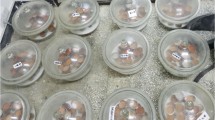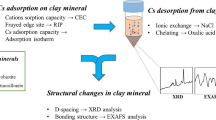Abstract
Purpose
Bound water has a large impact on physical and chemical properties of clay. The objective of this study was to investigate the contents, types, and physical properties of bound water and provide insights for understanding the thermal behavior and hydration process of the marine mucky silty clay under the control of bound water.
Materials and methods
An integrated approach incorporating isothermal adsorption, thermogravimetric analysis (TGA), and specific gravity testing were developed to determine the contents and the boundaries of different types of bound water in Qingdao clay and investigate their physical characteristics.
Results and discussion
Adsorption isotherm can be divided into two phases, which are the formation of strongly bound water and some capillary water under condition of p/ps < 0.9 and the formation of weakly bound water in the coverage for p/ps > 0.9. The initial dehydration temperatures of strongly bound water range between 87 and 92 °C in the hydrated clays under condition of p/ps < 0.98. Weakly bound water starts to be released at temperatures near 60 °C and is completely removed at temperatures between 90 and 108 °C. Capillary water and free water are evaporated before 60 °C. The specific gravity of hydrated clay decreases linearly with adsorbed water contents. The volume of hydrated clay, volume of adsorbed water, and thickness of water film approximately linearly increase with adsorbed water contents.
Conclusions
Quantitative determination and classification for bound water can be implemented through thermogravimetry (TG) and derivative thermogravimetry (DTG) curves. The physical properties of hydrated clay and bound water film are directly affected by the adsorbed water contents. The results may contribute to environmental and engineering risk assessment.




Similar content being viewed by others
References
Bachmaf S, Merkel BJ (2010) Sorption of uranium (VI) at the clay mineral-water interface. Environ Earth Sci 63(5):925–934
Barros N, Salgado J, Feijóo S (2007) Calorimetry and soil. Thermochim Acta 458(1–2):11–17
Bian B, Zhang LM, Zhang Q, Zhang SP, Yang Z, Yang WB (2018) Coupled heating/acidification pretreatment of chemical sludge for dewatering by using waste sulfuric acid at low temperature. Chemosphere 205:260–266
Cancela GD, Huertas FJ, Taboada ER, Sanchez-Rasero F, Laguna AH (1997) Adsorption of water vapor by homoionic montmorillonites. Heats of adsorption and desorption. J Colloid Interface Sci 185(2):343–354
Cases JM, Berend I, Francois M, Uriot JP, Michot LJ, Thomas F (1997) Mechanism of adsorption and desorption of water vapor by homoionic montmorillonite: 3. The Mg2+, Ca2+, Sr2+ and Ba2+ exchanged forms. Clay Clay Miner 45(1):8–22
Chen C, Wu S (1998) The influence of relative humidity on the adsorption of toluene by soils. Interpretation with the adsorption energy distribution functions. Chemosphere 37:1437–1444
Chen J, Anandarajah A, Inyang H (2000) Pore fluid properties and compressibility of kaolinite. J Geotech Geoenviron 126(9):798–807
Dolinar B (2014) Prediction of the soil-water characteristic curve based on the specific surface area of fine-grained soils. Bull Eng Geol Environ 74(3):697–703
Eisenberg D, Kauzmann W (2005) The structure and properties of water. Clarendon Press, Oxford
Fan JX, Wang YJ, Cui XD, Zhou DM (2013) Sorption isotherms and kinetics of Sb(V) on several Chinese soils with different physico-chemical properties. J Soils Sediments 13(2):344–353
Ferrage E, Lanson B, Sakharov BA, Drits VA (2005) Investigation of smectite hydration properties by modeling experimental X-ray diffraction pattern. Part I Montmorillonite hydration properties. Am Mineral 90(8–9):1358–1374
Freundlich HMF (1906) Over the adsorption in solution. J Phys Chem 57:384–470
GB/T50123-1999 (1999) Standard for soil test method. China Planning Press, Beijing (in Chinese)
Halsey GD (1948) Physical adsorption on nonuniform surfaces. J Chem Phys 16(10):931–937
Hilhorst MA, Dirksen C, Kampers FWH, Feddes RA (2001) Dielectric relaxation of bound water versus soil matric pressure. Soil Sci Soc Am J 65(2):311–314
Huang YT, Hseu ZY, Hsi HC (2011) Influences of thermal decontamination on mercury removal, soil properties, and repartitioning of coexisting heavy metals. Chemosphere 84:1244–1249
Huang Y, Liu Z, He Y, Zeng F, Wang R (2013) Quantifying effects of primary parameters on adsorption-desorption of atrazine in soils. J Soils Sediments 13(1):82–93
Jin B, Wilen BM, Lant P (2004) Impacts of morphological, physical and chemical properties of sludge flocs on dewaterability of activated sludge. Chem Eng J 98(1–2):115–126
Kasprzhitskii A, Lazorenko G, Sulavko S, Yavna V, Kochur A (2016) A study of the structural and spectral characteristics of free and bound water in kaolinite. Opt Spectrosc 121(3):357–363
Kucerik J, Demyan MS, Siewert C (2016) Practical applications of thermogravimetry in soil science. Part 4: relationship between clay, organic carbon and organic matter contents. J Therm Anal Calorim 123(3):2441–2450
Kucerik J, Tokarski D, Demyan MS, Merbach I, Siewert C (2018) Linking soil organic matter thermal stability with contents of clay, bound water, organic carbon and nitrogen. Geoderma 316:38–46
Kuligiewicz A, Derkowski A (2017) Tightly bound water in smectites. Am Mineral 102(5):1073–1090
Langmuir I (1918) The adsorption of gases on plane surfaces of glass, mica and platinum. J Am Chem Soc 40(12):1361–1403
Li SL, Bo ZZ (1982) Translation collection of adsorbed water in soil. Geological Publishing House, Beijing
Li YL, Wang TH, Su LJ (2015) Determination of bound water content of loess soils by isothermal adsorption and thermogravimetric analysis. Soil Sci 180(3):90–96
Liu H, Liu P, Hu H, Zhang Q, Wu Z, Yang J, Yao H (2014) Combined effects of Fenton peroxidation and CaO conditioning on sewage sludge thermal drying. Chemosphere 117:559–566
Low PF (1979) Nature and properties of water in montmorillonite-water system. Soil Sci Soc Am J 43(5):651–658
Martin RT (1962) Adsorbed water on clay: a review. Clay Clay Miner 9(1):28–70
Morin R, Silva AJ (1984) The effects of high pressure and high temperature on some physical properties of ocean sediments. J Geophys Res Solid Earth 89(B1):511–526
Neuhaus D (2013) Water adsorption and desorption pretreatment of surfaces increases the maximum amount of adsorbed water molecules by a multiple. Adsorption 19(6):1127–1135
Osipov VI (2012) Nanofilms of adsorbed water in clay: mechanism of formation and properties. Water Resour 39(7):709–721
Prost R, Koutit T, Benchara A (1998) State and location of water adsorbed on clay minerals: consequences of the hydration and swelling-shrinkage phenomena. Clay Clay Miner 46(2):117–131
Robinson DA, Cooper JD, Gardner CMK (2002) Modelling the relative permittivity of soils using soil hygroscopic water content. J Hydrol 255(1–4):39–49
Sing KSW (1985) Reporting physisorption data for gas/solid systems with special reference to the determination of surface area and porosity (recommendations 1984). Pure Appl Chem 57(4):603–619
Smith JK, Vesilind PA (1995) Dilatometric measurement of bound water in wastewater sludge. Water Res 29(12):2621–2626
Sposito G, Prost R (1982) Structure of water adsorbed on smectites. Chem Rev 82(6):553–573
Stepkowska ET, Pérez-Rodríguez JL, Maqueda C, Starnawska E (2004) Variability in water sorption and in particle thickness of standard smectites. Appl Clay Sci 24(3–4):185–199
Sun Q, Zhang WQ, Qian HT (2016) Effects of high temperature thermal treatment on the physical properties of clay. Environ Earth Sci 75(7):610
Tangaraj V, Janot J-M, Jaber M, Bechelany M, Balme S (2017) Adsorption and photophysical properties of fluorescent dyes over montmorillonite and saponite modified by surfactant. Chemosphere 184:1355–1361
Wang PQ (2001) Study for quantitative analysis of water on clays and their hydration mechanism. Graduate School of Southwest Petroleum Institute (dissertation for PhD) (in Chinese)
Wang Y, Lu S, Ren T, Li BG (2011) Bound water content of air-dry soils measured by thermal analysis. Soil Sci Soc Am J 75(2):481–487
Wang TH, Li YL, Su LJ (2014) Types and boundaries of bound water on loess particle surface. Chin J Geotech Eng 36(5):942–948 (in Chinese)
Wong JTF, Chen Z, Chen X, Ng CWW, Wong MH (2017) Soil-water retention behavior of compacted biochar-amended clay: a novel landfill final cover material. J Soils Sediments 17(3):590–598
Wu CC, Lee DJ, Huang CP (1998) Bound water content and water binding strength on sludge flocs. Water Res 32(3):900–904
Ye C, Guo ZL, Cai CF, Wang JG, Deng J (2017) Effect of water content, bulk density, and aggregate size on mechanical characteristics of Aquults soil blocks and aggregates from subtropical China. J Soils Sediments 17(1):210–219
Yen PS, Lee DJ (2001) Errors in bound water measurements using centrifugal setting method. Water Res 35(16):4004–4009
Yuan YJ, Rezaee R, Verrall M, Hu S-Y, Zou J, Testmanti N (2018) Pore characterization and clay bound water assessment in shale with a combination of NMR and low-pressure nitrogen gas adsorption. Int J Coal Geol 194:11–21
Acknowledgments
This work was supported by the Natural Science Foundations of China (Grant No. 41572257). The authors would like to thank Dr. Han Jing (College of Construction Engineering, Jilin University) for her contribution in data collection.
Author information
Authors and Affiliations
Corresponding author
Ethics declarations
Conflict of interest
The authors declare that they have no conflict of interest.
Additional information
Responsible editor: Yi Jun Xu
Publisher’s note
Springer Nature remains neutral with regard to jurisdictional claims in published maps and institutional affiliations.
Rights and permissions
About this article
Cite this article
Li, S., Wang, C., Zhang, X. et al. Classification and characterization of bound water in marine mucky silty clay. J Soils Sediments 19, 2509–2519 (2019). https://doi.org/10.1007/s11368-019-02242-5
Received:
Accepted:
Published:
Issue Date:
DOI: https://doi.org/10.1007/s11368-019-02242-5




